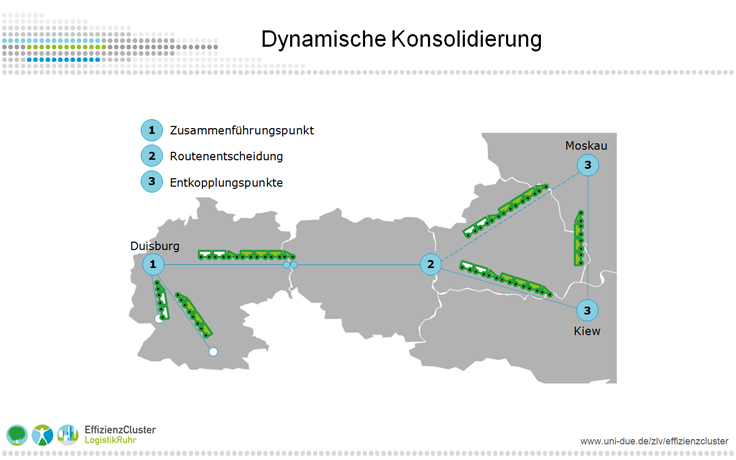Dynamic Consolidation
Project description
The aim of the project „Dynamic Consolidation“ is the provision of logistic concepts for the introduction of flexible (dynamic) connections in rail freight traffic – especially for the connection Duisburg – Moscow.
Nowadays, traffic by train is carried out mainly in the form of a complete train (block train) that is consolidated at the starting point and runs to the arrival point in the same constellation. Another frequently used possibility provides the transport of single wagons individually by freight trains running according to time-tables (wagonload freight).
In the last case a freight train only runs sections of line, which means that the wagon has to be coupled and uncoupled multiple times. Thereby a lot of time is lost but also the danger of misdirections respectively „lost“ of wagons exists. The usage of block trains primarily reduces the named dangers indeed but is a very inflexible transport concept, because on the whole line between starting point and arrival point no wagons are coupled respectively uncoupled.
As an alternative to wagonload freight and block train the concept of parallel running trains can be used. Here several wagons according to place of origin respectively destination are coupled and routed together as a part train (parallel running train). Then those parallel running trains are coupled at certain consolidating points respectively become uncoupled. Such a system can be called hub and spoke network. According to the actual demand the use of different railway networks can make sense.
When, for example, a parallel running train is provided in Ludwigshafen with destination Kiev this train runs to Duisburg on its own, there it is combined with further parallel running trains to a big network and runs from there as a whole to the East. The whole train can be directed via Kiev so that the corresponding part can be disconnected there. If such demands do not even exist a flexible routing can ensure that the route of lines will be changed that way that the train can be routed with minimal cost and time (directly connected). Currently the concept of parallel running trains is especially assigned in passenger traffic but not in rail freight.
Hence, the aim of the project is the provision of a logistic concept that enables the organization of parallel running trains with dynamic consolidation. This concept has to consider a multiplicity of problems respectively has to solve these. On the one hand technical and legal general requirements have to be reconsidered and on the other hand problems resulting from this have to be solved respectively considered. So among the problem of different track gauges also questions of customs law and judicial questions of transport have to be resolved.
However, the main part of the research project is the provision of decision support tools (software) for making concrete practical decisions via which lines the routing has to be made.
A tracking and tracing system that enables the localization of single wagons via GPS/ Galileo is part of the software package that has to be programmed. This tracking and tracing system allows not only that position data can be transmitted to the customers, but it also provides the system the possibility to recognize delays or other unscheduled occurrences and to initiate counteractive measures.
Once made available, the new logistic concept allows, together with the corresponding software tools, the introduction of continuously operating flexible routed rail freight – not only towards Moscow – but generally also as a connection with further urban centres in Europe. As a direct result of the establishment of such a connection between Duisburg and Moscow a job creation of about 300 can be expected.

